Another species on our search radar in October 2021 (see previous post about Calotis glabrescens) was the twining vine Vincetoxicum forsteri (until 2018 known as Tylophora linearis), which is listed as endangered under the EPBC Act (Cth) and the Nature Conservation Act (Qld). This very cryptic twiner of the Apocynaceae family was first described by Paul Forster of the Queensland Herbarium in 1992 from collections made in south-east Qld only four times, in 1913, 1914, 1960 and 1969 (Forster, Binns & Robertson, 2004). A small number of populations were discovered in central NSW around 2003 (Forster, Binns & Robertson, 2004), and the species is now relatively well-known in that state (where it has been collected extensively by the outstanding RPS ecologist Mark Aitkens). But until recently V. forsteri had remained elusive in Queensland since 1968.
However, a GHD survey in 2018 in the Gore-Karara-Goldfields area found one individual growing on a rabbit fence on the boundary of Durakai State Forest. Therefore, during targeted protected plant surveys conducted by the Astrebla/Red Ash/GHD botany team in 2021, V. forsteri was one of the species we had high hopes of finding.
Eureka!
Well, we found them! Nearly 300 stems in four main populations occupying almost 90 ha. It is an extraordinarily difficult species to detect unless you slow your survey speed right down, because it is very slender (stems ~3 mm dia., leaves only a few mm wide and up to 10 cm long) (see pic below). In addition, it tends to twine up dense shrubs or coppicing trees, so is easily lost to sight among coarser vegetation. If it is flowering, the purple flowers will generally make it more easily detectable. It is my firm belief that unless protected plant surveys targeting this species are conducted at suitably slow speeds, this species will almost certainly be missed (which I’m sure occurs from time to time).


Habitat
Our surveys found V. forsteri in two main vegetation types, open forest dominated by Eucalyptus fibrosa subsp. nubilis with E. sideroxylon (RE 13.11.5) and open forest dominated by E. dealbata with E. crebra (RE 13.11.3). We also found a number growing on the mesh fences erected decades ago to control rabbits (but none on standard barbed wire fences). Some had even started to grow on the new so-called ‘cluster fences’ recently erected across the landscape in this district with massive funding from government. These fences prevent the widespread movement of macropods and other native mammals, and I predict they will have a massively detrimental impact on many least concern species in the area – but that is a topic for another blog!

We found V. forsteri stems twining in the following situations:
- The most common species we found it twining on was Olearia canescens, usually dead but standing
- Vincetoxicum forsteri was also frequently found climbing coppicing E. fibrosa stems (see pic – many of the areas surveyed are the subject of private logging ventures),
- More uncommonly it was found climbing on Acacia leiocalyx or A. fimbriata shrubs, either alive or dead (but still standing).
In the survey area, these habitat types occur in a mosaic with open forest dominated almost exclusively by Corymbia citriodora (RE 13.11.6). We rarely found Vincetoxicum forsteri in association with C. citriodora – it appears to have a clear preference for habitat occupied by ironbarks, and E. dealbata.
We also found it along the verges of logging tracks.
Vincetoxicum forsteri has been previously associated in the main with dense shrubland (Forster et al., 2004). However, the open forest habitats in which we found these V. forsteri populations did not have dense shrub layers – in general, these open forests had very sparse to sparse shrub layers, with clear visibility for 50 m or more in most directions. We did not find any plants in the nearby areas characterised by a dense Olearia canescens shrub layer. This could be because the dense habitat makes it harder to detect, although overall 4 botanists walked just over 500 km of transects for this survey, of which at least 80 km was in areas with dense O. canescens – so these areas were well-surveyed.
Most individuals were found in areas where logging was active – although it is not known how populous the species was prior to logging, which is believed to have been practiced here for many decades.
It is interesting to note that in this area, V. forsteri is present with extensive populations of the vulnerable cycad Macrozamia conferta, another species whose populations we were mapping, and which co-occurs with forestry activities. This cycad is endemic to the Durikai-Talgai-Bringalily State Forest area, and this population is believed to be the largest on private land.

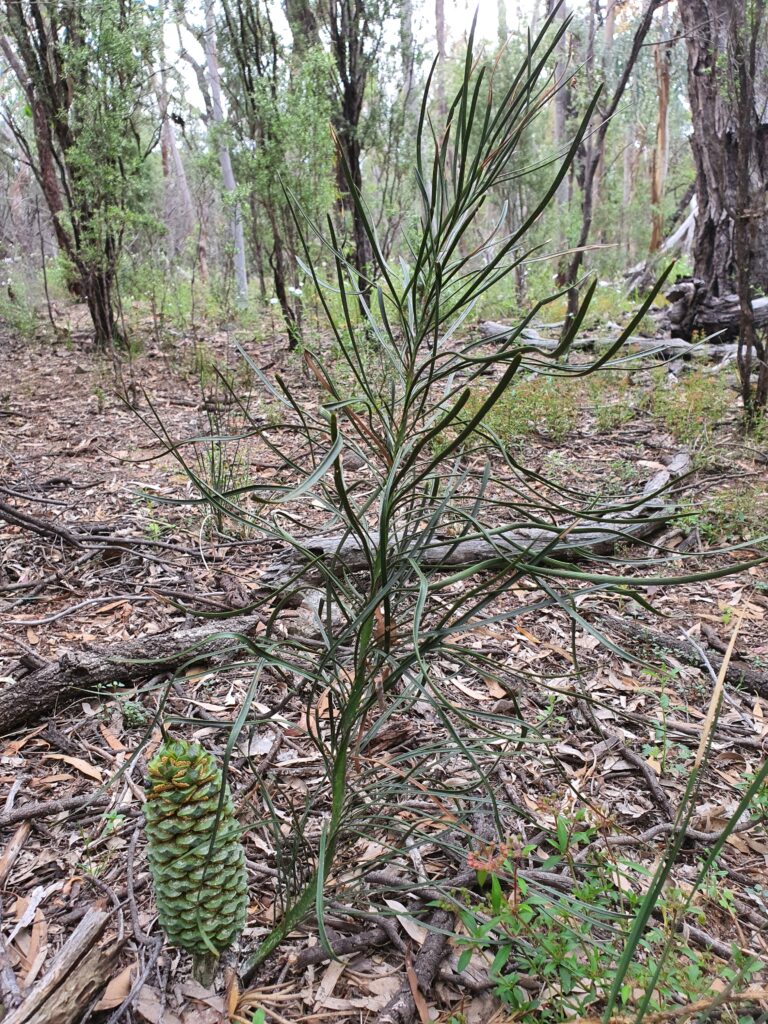
References
Forster, P.I., Binns, D. and Roberston, G., 2004, Rediscovery of Tylophora linearis P.I. Forster (Apocynaceae: Asclepiodoideae) from New South Wales, with revision of its conservation status to vulnerable. Austrobaileya 6 (4): 942-946.


 Listed as endangered in Queensland and under the EPBC Act, this species is a rare slender twining vine distinguished by its small lanceolate, herbaceous, opposite leaves with purplish-red petioles and clear sap
Listed as endangered in Queensland and under the EPBC Act, this species is a rare slender twining vine distinguished by its small lanceolate, herbaceous, opposite leaves with purplish-red petioles and clear sap Tylophora rupicola was recorded from low closed and open forests, mostly grassy, on rhyolite slopes in association with Lophostemon confertus, Acacia aulococarpa, Eucalyptus granitica, Corymbia abergiana, E. reducta, Allocasuarina littorlis, Syncarpia glomulifera and C. citriodora, always slightly upslope of rocky minor watercourses (regional ecosystems 7.12.30d and 7.12.66c).
Tylophora rupicola was recorded from low closed and open forests, mostly grassy, on rhyolite slopes in association with Lophostemon confertus, Acacia aulococarpa, Eucalyptus granitica, Corymbia abergiana, E. reducta, Allocasuarina littorlis, Syncarpia glomulifera and C. citriodora, always slightly upslope of rocky minor watercourses (regional ecosystems 7.12.30d and 7.12.66c). Dendrobium fellowsii F. Muell. (Orchidaceae) (native damsel orchid)
Dendrobium fellowsii F. Muell. (Orchidaceae) (native damsel orchid) Dallachy collected it in the 1860s from the Cardwell area, and it was described by Baron Ferdinand von Mueller in 1870. Mueller named it after Thomas Howard Fellows, a short-termed Attorney General of colonial Victoria and later a Supreme Court judge. Dendrobium fellowsii is also known as Eleutheroglossum fellowsii (F. Muell.) M.A. Clem. & D.L. Jones.
Dallachy collected it in the 1860s from the Cardwell area, and it was described by Baron Ferdinand von Mueller in 1870. Mueller named it after Thomas Howard Fellows, a short-termed Attorney General of colonial Victoria and later a Supreme Court judge. Dendrobium fellowsii is also known as Eleutheroglossum fellowsii (F. Muell.) M.A. Clem. & D.L. Jones.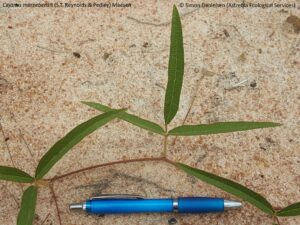 Cajanus mareebensis (S.T. Reynolds & Pedley) Maesen (Fabaceae)
Cajanus mareebensis (S.T. Reynolds & Pedley) Maesen (Fabaceae) Macrozamia conferta (D.L. Jones & P.I. Forster)
Macrozamia conferta (D.L. Jones & P.I. Forster)
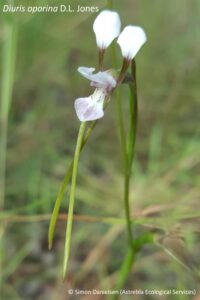 Diuris oporina D.L. Jones (Orchidaceae)
Diuris oporina D.L. Jones (Orchidaceae) Diuris oporina has until recently been thought to be restricted to the drier western ranges of the Atherton and Evelyn Tablelands in North Queensland. However, material collected as far back as 1953 (and apparently only identified recently) indicates this species has also been found in ranges in the vicinity of Airlie Beach and the Eungella Tableland, and from the Central Highlands in sandstone ranges of the Carnarvon Gorge and Palmgrove National Parks. These are significant range extensions, and indicate that much is yet to be learnt about this beautiful orchid.
Diuris oporina has until recently been thought to be restricted to the drier western ranges of the Atherton and Evelyn Tablelands in North Queensland. However, material collected as far back as 1953 (and apparently only identified recently) indicates this species has also been found in ranges in the vicinity of Airlie Beach and the Eungella Tableland, and from the Central Highlands in sandstone ranges of the Carnarvon Gorge and Palmgrove National Parks. These are significant range extensions, and indicate that much is yet to be learnt about this beautiful orchid.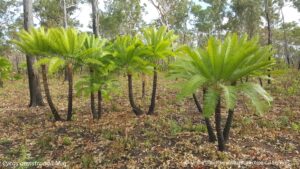 Cycas armstrongii Miq. (Cycadaceae)
Cycas armstrongii Miq. (Cycadaceae) This cycad is relatively easily identified as it has flat to recurved (not revolute) leaflet margins, ovoid-globose pollen (male) cones and densely orange tomentose, pungent cataphylls (illustrated in the lower image – cataphylls are the young leaves). The mature adult leaf blades are green and shiny.
This cycad is relatively easily identified as it has flat to recurved (not revolute) leaflet margins, ovoid-globose pollen (male) cones and densely orange tomentose, pungent cataphylls (illustrated in the lower image – cataphylls are the young leaves). The mature adult leaf blades are green and shiny. Aristida annua B.K. Simon (Poaceae)
Aristida annua B.K. Simon (Poaceae)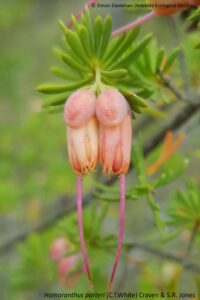 Homoranthus porteri (C.T. White) Craven & S.R. Jones (Myrtaceae)
Homoranthus porteri (C.T. White) Craven & S.R. Jones (Myrtaceae) Homoranthus porteri is restricted to upland areas of rock pavement in ranges along the western fringe of the Atherton Tableland, with outlying populations at Mt Windsor (inland from the Daintree River), Mt Mulligan and the Hann Tableland.
Homoranthus porteri is restricted to upland areas of rock pavement in ranges along the western fringe of the Atherton Tableland, with outlying populations at Mt Windsor (inland from the Daintree River), Mt Mulligan and the Hann Tableland.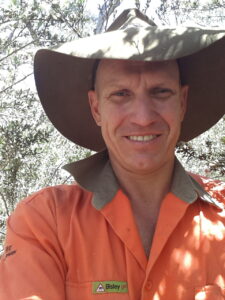 Simon Danielsen is a recognised ‘suitably qualified person’ under the Queensland Nature Conservation (Wildlife Management) Regulation 2006 to conduct protected plant surveys, and has conducted over 30 such surveys under the Protected Plant Survey Guidelines to date.
Simon Danielsen is a recognised ‘suitably qualified person’ under the Queensland Nature Conservation (Wildlife Management) Regulation 2006 to conduct protected plant surveys, and has conducted over 30 such surveys under the Protected Plant Survey Guidelines to date.